Abstract
1. Chemical responses of polymodal receptors of the superior spermatic nerve were studied by single unit recording in dogs. The responses were similar to those found in the muscular polymodal receptors of dogs. 2. Solutions of hypertonic NaCl, KCl and bradykinin caused responses in more than 90% of these polymodal units. The responses were related to the dose of these three chemical but discharge patterns differed substantially. Responses to Na citrate were very capricious, and those to acetylcholine and histamine were weak. 3. When bradykinin was applied repeatedly the responses of the subsequent trials decreased if the repetition interval was short (less than 15 min), but an increase of response was observed if the repetition interval was long (30-60 min). 4. Indomethacin 10 micrograms.ml-1 suppressed or abolished the response to 1 microgram.ml-1 bradykinin without significant influence on the response to 60 mmol.l-1 KCl at the same receptive site. Involvement of prostaglandins in the response of the polymodal units to bradykinin is suggested.
Full text
PDF
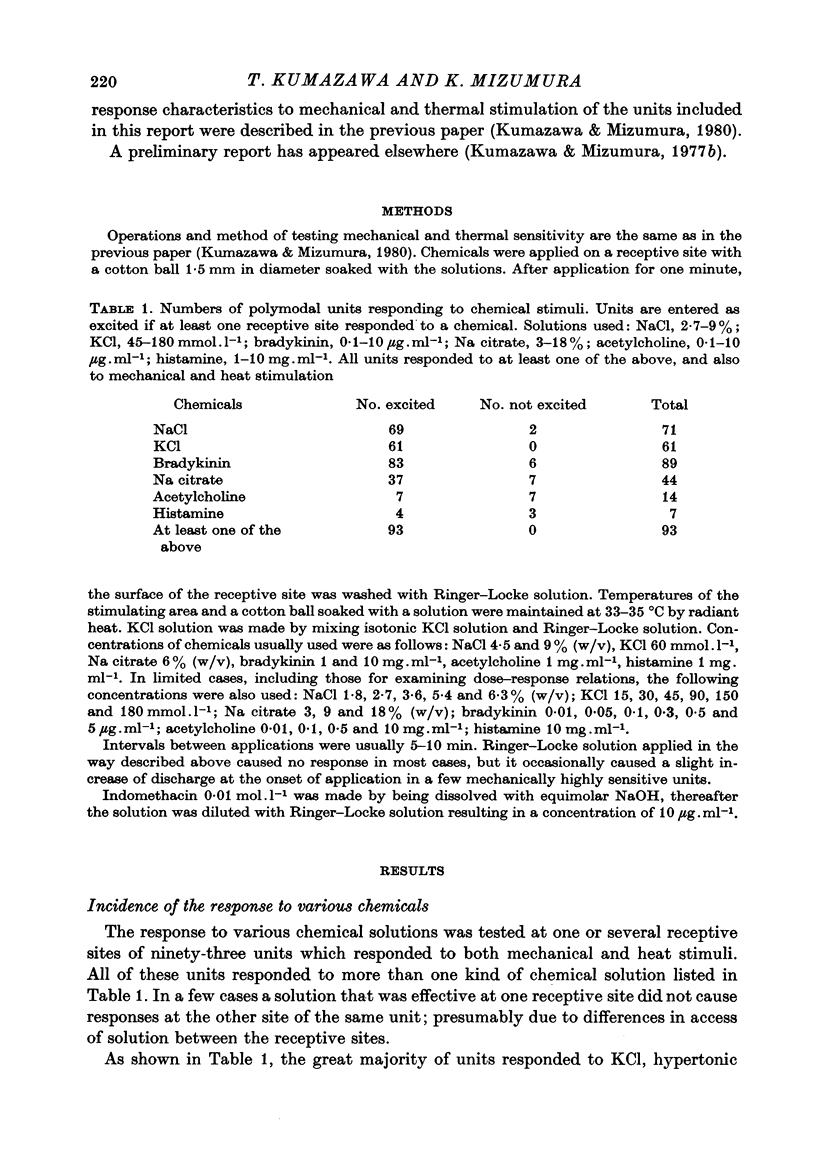

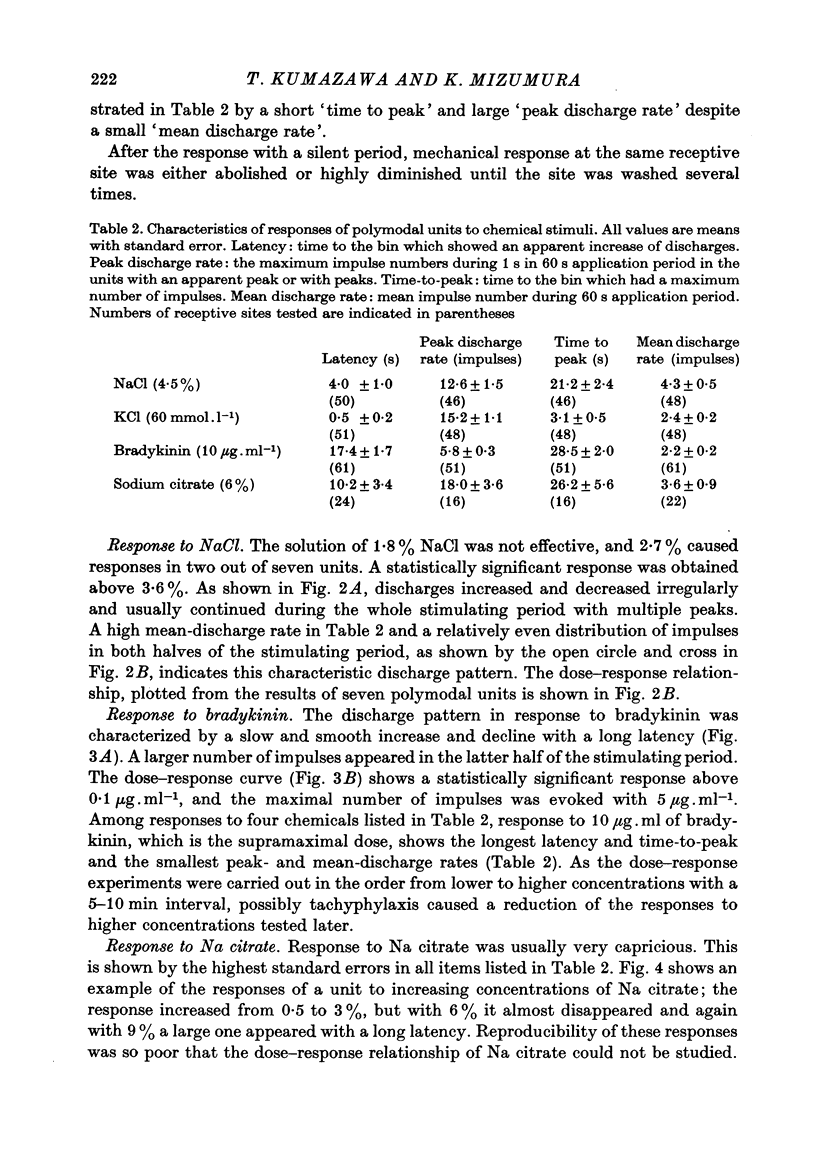
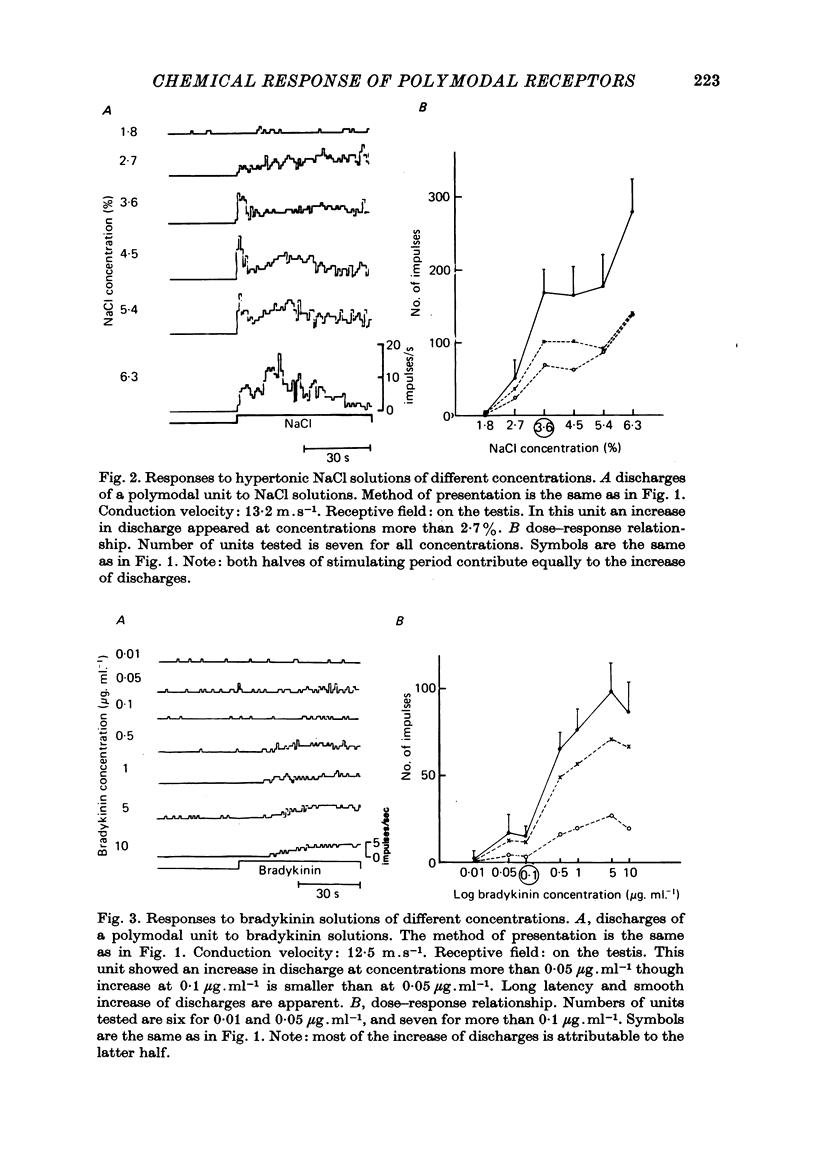


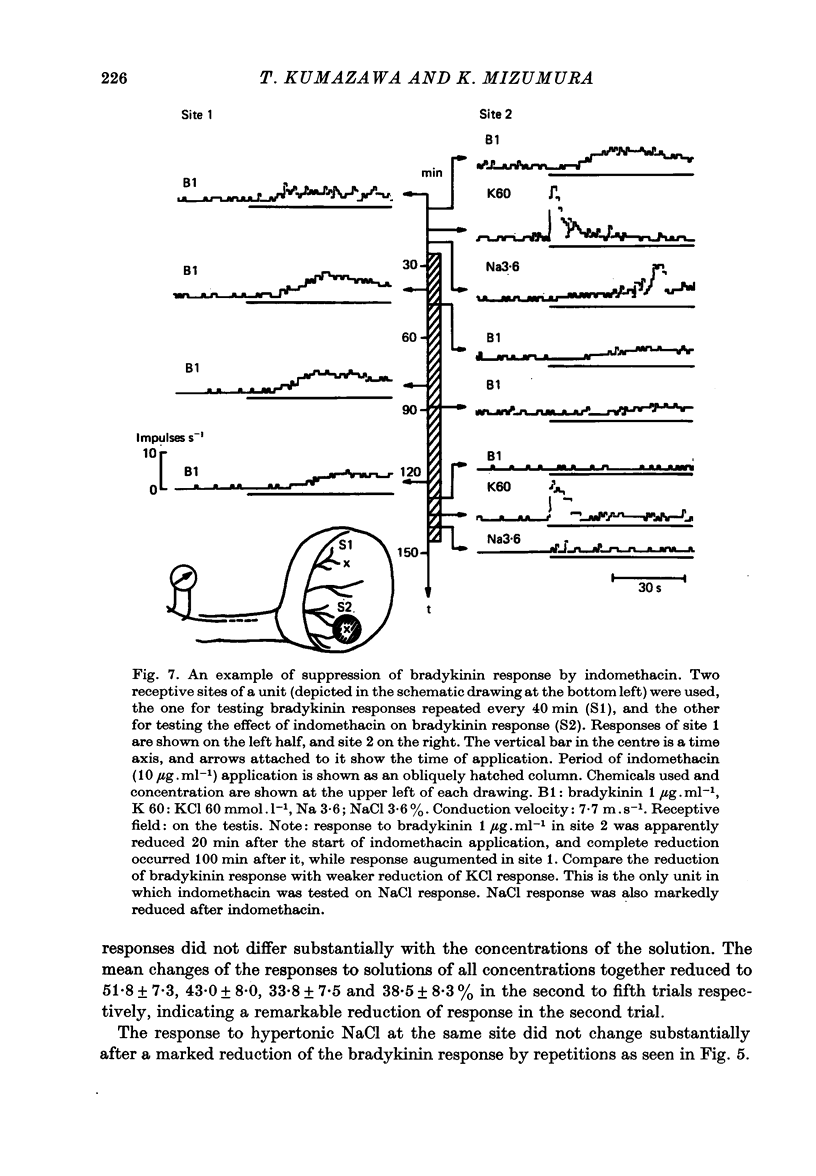




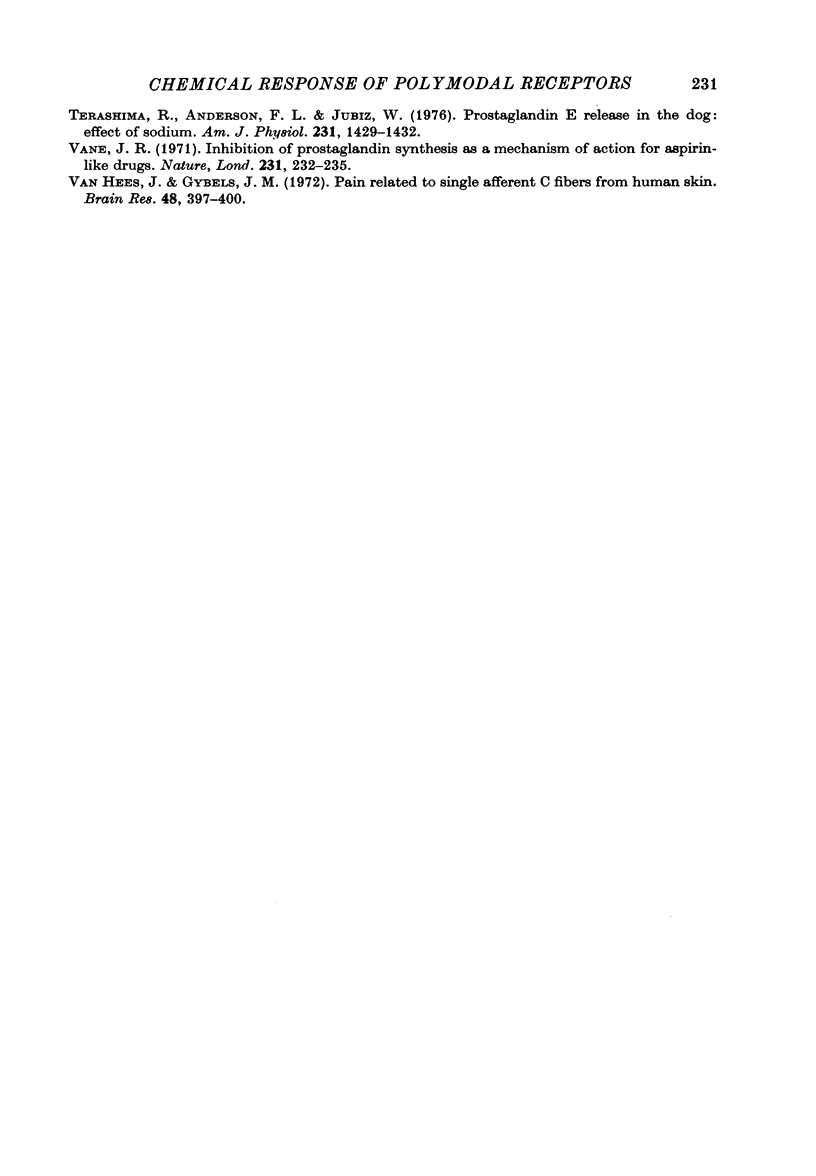
Selected References
These references are in PubMed. This may not be the complete list of references from this article.
- Albus K., Beckmann R. Second and third visual areas of the cat: interindividual variability in retinotopic arrangement and cortical location. J Physiol. 1980 Feb;299:247–276. doi: 10.1113/jphysiol.1980.sp013123. [DOI] [PMC free article] [PubMed] [Google Scholar]
- Beck P. W., Handwerker H. O. Bradykinin and serotonin effects on various types of cutaneous nerve fibers. Pflugers Arch. 1974 Mar 11;347(3):209–222. doi: 10.1007/BF00592598. [DOI] [PubMed] [Google Scholar]
- Beitel R. E., Dubner R. Response of unmyelinated (C) polymodal nociceptors to thermal stimuli applied to monkey's face. J Neurophysiol. 1976 Nov;39(6):1160–1175. doi: 10.1152/jn.1976.39.6.1160. [DOI] [PubMed] [Google Scholar]
- Bessou P., Perl E. R. Response of cutaneous sensory units with unmyelinated fibers to noxious stimuli. J Neurophysiol. 1969 Nov;32(6):1025–1043. doi: 10.1152/jn.1969.32.6.1025. [DOI] [PubMed] [Google Scholar]
- Croze S., Duclaux R., Kenshalo D. R. The thermal sensitivity of the polymodal nociceptors in the monkey. J Physiol. 1976 Dec;263(3):539–562. doi: 10.1113/jphysiol.1976.sp011644. [DOI] [PMC free article] [PubMed] [Google Scholar]
- Ferreira S. H., Moncada S., Vane J. R. Prostaglandins and the mechanism of analgesia produced by aspirin-like drugs. Br J Pharmacol. 1973 Sep;49(1):86–97. doi: 10.1111/j.1476-5381.1973.tb08270.x. [DOI] [PMC free article] [PubMed] [Google Scholar]
- Floyd K., Hick V. E., Koley J., Morrison J. F. The effects of bradykinin on afferent units in intra-abdominal sympathetic nerve trunks. Q J Exp Physiol Cogn Med Sci. 1977 Jan;62(1):19–25. doi: 10.1113/expphysiol.1977.sp002373. [DOI] [PubMed] [Google Scholar]
- HASHIMOTO K., KUMAKURA S., TAIRA N. VASCULAR REFLEX RESPONSES INDUCED BY AN INTRAARTERIAL INJECTION OF AZAAZEPINOPHENOTHIAZINE, ANDROMEDOTOXIN, VERATRIDINE, BRADYKININ AND KALLIKREIN AND BLOCKING ACTION OF SODIUM SALICYLATE. Jpn J Physiol. 1964 Jun 15;14:299–308. doi: 10.2170/jjphysiol.14.299. [DOI] [PubMed] [Google Scholar]
- Hiss E., Mense S. Evidence for the existence of different receptor sites for algesic agents at the endings of muscular group IV afferent units. Pflugers Arch. 1976 Mar 30;362(2):141–146. doi: 10.1007/BF00583640. [DOI] [PubMed] [Google Scholar]
- Juan H., Lembeck F. Action of peptides and other algesic agents on paravascular pain receptors of the isolated perfused rabbit ear. Naunyn Schmiedebergs Arch Pharmacol. 1974;283(2):151–164. doi: 10.1007/BF00501142. [DOI] [PubMed] [Google Scholar]
- Kumazawa T., Mizumura K. The polymodal C-fiber receptor in the muscle of the dog. Brain Res. 1976 Jan 23;101(3):589–593. doi: 10.1016/0006-8993(76)90483-2. [DOI] [PubMed] [Google Scholar]
- Kumazawa T., Mizumura K. The polymodal receptors in the testis of dog. Brain Res. 1977 Nov 18;136(3):553–558. doi: 10.1016/0006-8993(77)90080-4. [DOI] [PubMed] [Google Scholar]
- Kumazawa T., Mizumura K. Thin-fibre receptors responding to mechanical, chemical, and thermal stimulation in the skeletal muscle of the dog. J Physiol. 1977 Dec;273(1):179–194. doi: 10.1113/jphysiol.1977.sp012088. [DOI] [PMC free article] [PubMed] [Google Scholar]
- Kumazawa T., Perl E. R. Primate cutaneous sensory units with unmyelinated (C) afferent fibers. J Neurophysiol. 1977 Nov;40(6):1325–1338. doi: 10.1152/jn.1977.40.6.1325. [DOI] [PubMed] [Google Scholar]
- LIM R. K., GUZMAN F., RODGERS D. W., GOTO K., BRAUN C., DICKERSON G. D., ENGLE R. J. SITE OF ACTION OF NARCOTIC AND NON-NARCOTIC ANALGESICS DETERMINED BY BLOCKING BRADYKININ-EVOKED VISCERAL PAIN. Arch Int Pharmacodyn Ther. 1964 Nov 1;152:25–58. [PubMed] [Google Scholar]
- Lembeck F., Juan H. Interaction of prostaglandins and indomethacin with algesic substances. Naunyn Schmiedebergs Arch Pharmacol. 1974;285(4):301–313. doi: 10.1007/BF00501460. [DOI] [PubMed] [Google Scholar]
- Lembeck F., Popper H., Juan H. Release of prostaglandins by bradykinin as an intrinsic mechanism of its algesic effect. Naunyn Schmiedebergs Arch Pharmacol. 1976 Jul;294(1):69–73. doi: 10.1007/BF00692786. [DOI] [PubMed] [Google Scholar]
- McGiff J. C., Terragno N. A., Malik K. U., Lonigro A. J. Release of a prostaglandin E-like substance from canine kidney by bradykinin. Circ Res. 1972 Jul;31(1):36–43. doi: 10.1161/01.res.31.1.36. [DOI] [PubMed] [Google Scholar]
- Mense S. Nervous outflow from skeletal muscle following chemical noxious stimulation. J Physiol. 1977 May;267(1):75–88. doi: 10.1113/jphysiol.1977.sp011802. [DOI] [PMC free article] [PubMed] [Google Scholar]
- Moncada S., Ferreira S. H., Vane J. R. Inhibition of prostaglandin biosynthesis as the mechanism of analgesia of aspirin-like drugs in the dog knee joint. Eur J Pharmacol. 1975 Apr;31(2):250–260. doi: 10.1016/0014-2999(75)90047-3. [DOI] [PubMed] [Google Scholar]
- Scott D., Jr Aspirin: action on receptor in the tooth. Science. 1968 Jul 12;161(3837):180–181. doi: 10.1126/science.161.3837.180. [DOI] [PubMed] [Google Scholar]
- Taira N., Nakayama K., Hashimoto K. Vocalization response of puppies to intra-arterial administration of bradykinin and other algesic agents, and mode of actions of blocking agents. Tohoku J Exp Med. 1968 Dec;96(4):365–377. doi: 10.1620/tjem.96.365. [DOI] [PubMed] [Google Scholar]
- Terashima R., Anderson F. L., Jubiz W. Prostaglandin E release in the dog: effect of sodium. Am J Physiol. 1976 Nov;231(5 Pt 1):1429–1432. doi: 10.1152/ajplegacy.1976.231.5.1429. [DOI] [PubMed] [Google Scholar]
- Van Hees J., Gybels J. M. Pain related to single afferent C fibers from human skin. Brain Res. 1972 Dec 24;48:397–400. doi: 10.1016/0006-8993(72)90198-9. [DOI] [PubMed] [Google Scholar]
- Vane J. R. Inhibition of prostaglandin synthesis as a mechanism of action for aspirin-like drugs. Nat New Biol. 1971 Jun 23;231(25):232–235. doi: 10.1038/newbio231232a0. [DOI] [PubMed] [Google Scholar]


